Guest post outreach is one of the most effective ways to boost your SEO, increase your brand awareness, and build relationships with other bloggers and website owners in your niche. But it’s not as easy as it sounds.
You need to find the right sites to pitch, craft a compelling email that gets a positive response, and deliver high-quality content that meets their expectations and provides value to their audience.
In this article, I’ll show you how to master guest post outreach in 2023 and beyond. I’ll explain what guest post outreach is, why it’s important, and how to do it step by step. Also, I’ll share some dos and don’ts of guest post outreach that will help you avoid common pitfalls and increase your chances of success.
What is Guest Post Outreach?
Guest post outreach is the process of reaching out to other bloggers and websites and pitching them to publish your content on their site. The goal is to provide value to their audience, establish yourself as an authority in your niche, and get exposure to a new audience.
Guest posting is a form of content marketing that involves creating and distributing content for another website, usually in exchange for a link back to your own site. This link can help you improve your SEO rankings, drive more traffic to your site, and generate more leads and sales.
Guest blogging is actually the most popular link building strategy for Saas industry, and in general, with 64.9% of link builders using it, according to My Codeless Website.
Guest posting is also a great way to build relationships with other influencers and experts in your industry, who can help you grow your network, reach, and reputation. By guest posting on relevant and authoritative sites, you can showcase your expertise, share your insights, and demonstrate your value to potential customers.
Why is Guest Post Outreach Important?
Guest blogging outreach is important because it can help you achieve multiple benefits for your online business, such as:
- Building relationships: Guest posting can help you connect with other bloggers and website owners who share your interests, goals, and audience. You can build trust, rapport, and mutual respect with them, which can lead to more opportunities for collaboration, promotion, and referrals in the future.
- Increasing brand awareness: Guest posting can help you reach a wider audience that may not be aware of your brand or what you offer. You can introduce yourself, tell your story, and showcase your unique value proposition to potential customers who are looking for solutions to their problems.
- Improving SEO: Guest posting can help you improve your SEO by generating high-quality backlinks from relevant and authoritative sites. Backlinks are one of the most important ranking factors for Google and other search engines, as they indicate that your site is trustworthy, credible, and valuable. The more backlinks you have from reputable sites in your niche, the higher your site will rank for your target keywords.
- Generating leads: Guest posting can help you generate leads by attracting qualified traffic to your site. By providing valuable content that solves a problem or answers a question for the readers of the host site, you can entice them to visit your site to learn more about you and what you offer. You can also include a call to action (CTA) at the end of your guest post that invites them to sign up for your email list, download a free resource, or contact you for a consultation.
How to Do Guest Post Outreach Like A Boss!
Guest post outreach can be challenging and time-consuming if you don’t have a clear strategy and process. Here are some steps you can follow to make it easier and more effective:
1. Finding the best sites for guest posting
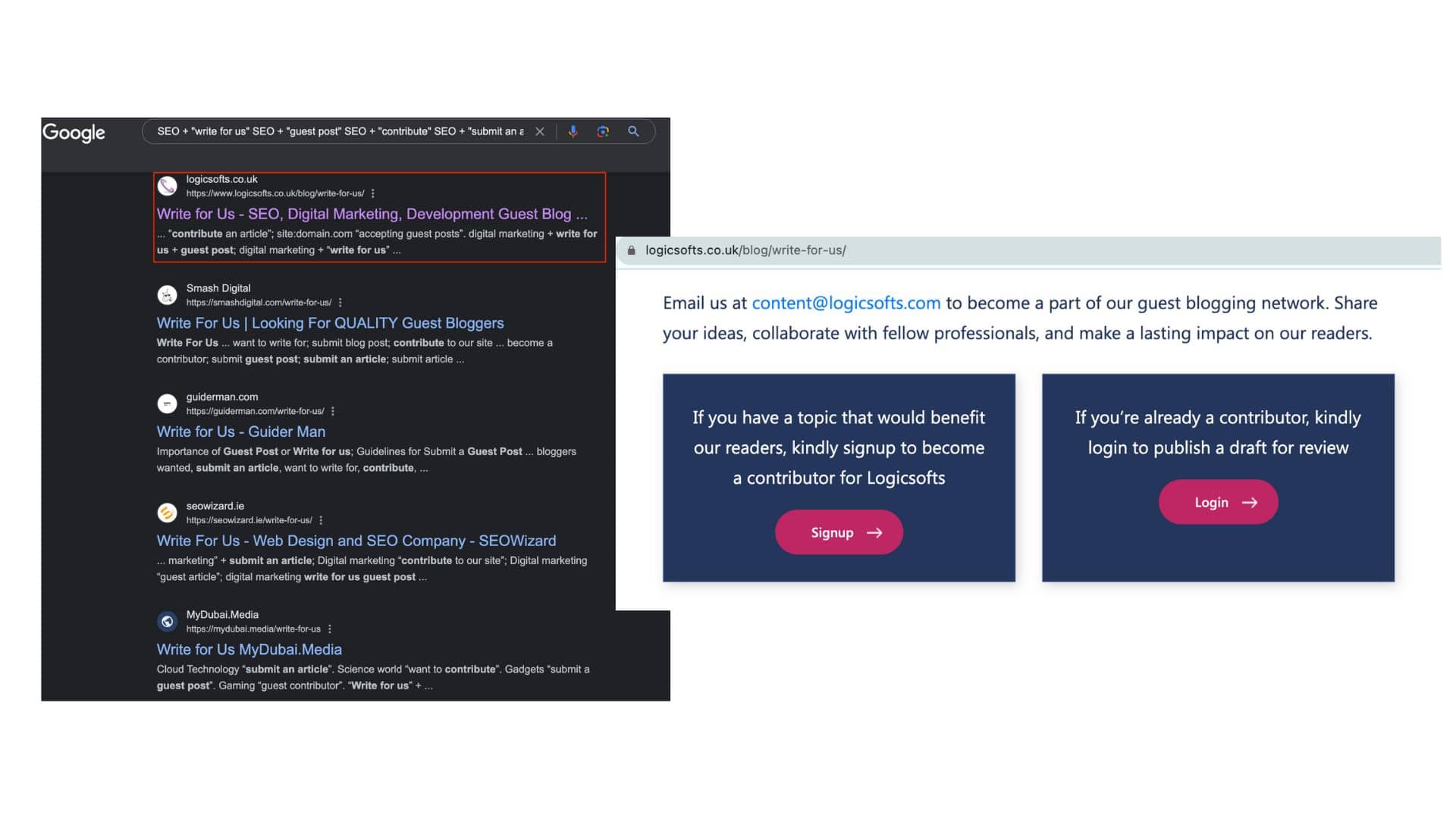
Search operators in action for the first step in guest post outreach.
The first step is to find the best sites for guest posting in your niche. You want to target sites that have:
- A large and engaged audience that matches your ideal customer profile
- A high domain rating (DR) that indicates their SEO strength and influence
- A relevant topic or theme that aligns with your niche and expertise
- A positive reputation and credibility in their industry
- A history of accepting guest posts from other writers
There are several ways you can find these sites, such as:
- Using Google search operators: You can use advanced search operators on Google to find sites that accept guest posts in your niche. For example, if you want to find guest post opportunities related to SEO, you can use queries like:
SEO + “write for us” SEO + “guest post” SEO + “contribute” SEO + “submit an article”
You can also use keywords related to your sub-niche or specific topic to narrow down your results.
- Using competitor analysis tools: You can use tools like Ahrefs to analyze the backlink profiles of your competitors and find out where they are getting their guest posts published. You can then reach out to the same sites and pitch them your own guest post ideas.
- Using guest post databases: You can use databases to find sites that accept guest posts in various niches and categories. You can filter the results by DR, niche, and other criteria to find the most suitable sites for your goals. You can easily find them by Googling: guest blog database.
- Using social media: You can use social media platforms like Twitter, Facebook, or LinkedIn to find sites that accept guest posts in your niche. You can search for hashtags like #guestpost, #guestblogging, or #writeforus, or follow influencers and experts who regularly share guest post opportunities on their profiles. You can also join groups and communities related to your niche and ask for recommendations or referrals from other members.
Once you have a list of potential sites for guest posting, you need to evaluate them and prioritize them based on their quality, relevance, and authority. You can use tools like SimilarWeb or Ahrefs to check their:
- Traffic
- Audience
- Engagement metrics
- DR
- Backlink profile
- Keyword rankings
You want to focus on the sites that have the most potential to help you achieve your guest blogging outreach goals, whether it’s building relationships, increasing brand awareness, improving SEO, or generating leads.
2. Choosing an outreach method

The next step is to choose an outreach method that works best for you and the sites you want to pitch. There are two main methods you can use:
- Email outreach: This is the most common and effective method of guest blogging outreach. It involves sending a personalized email to the site owner or editor and pitching them your guest post idea. Email outreach allows you to communicate directly with the decision-maker, showcase your value proposition, and follow up until you get a response.
- Social media outreach: This is an alternative or complementary method of guest blogger outreach. It involves reaching out to the site owner or editor via social media platforms like Twitter, Facebook, or LinkedIn and starting a conversation with them. Social media outreach allows you to build rapport, show interest, and establish trust before pitching your guest post idea.
Both methods have their pros and cons, so you need to experiment and see what works best for you and the sites you want to pitch. You can also use a combination of both methods to increase your chances of getting a positive response.
3. Researching the people you’ll be outreaching to
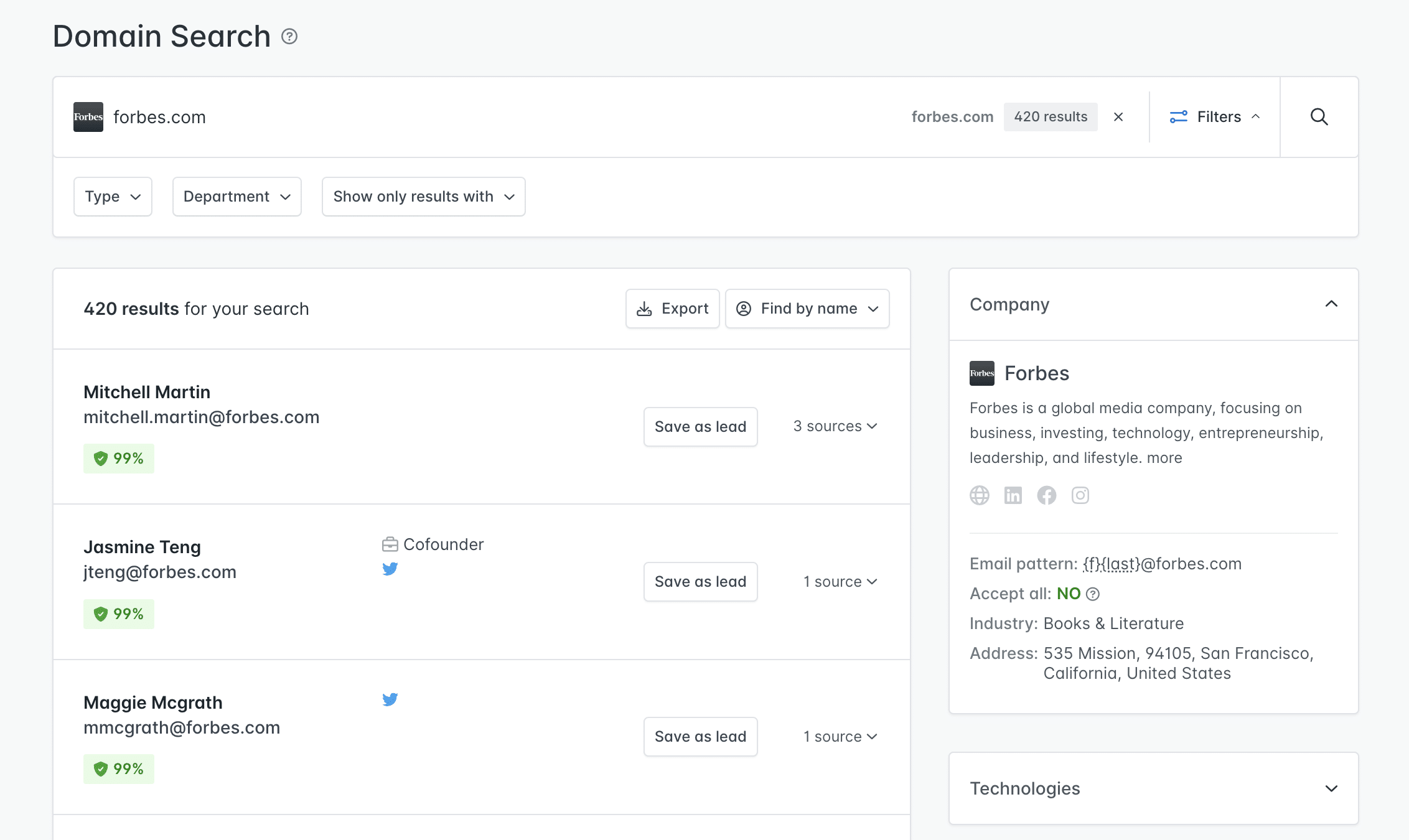
With Hunter, you can easily plug in a domain and find all the people associated to it, which makes the research process much easier.
The next step is to research the people for the guest blogger outreach and learn more about them. This will help you personalize your pitch, tailor your content, and increase your chances of getting a positive response.
You need to find out:
- Their name and role: You want to address them by their name and title, not by generic salutations like “Dear Sir/Madam” or “To Whom It May Concern”. This shows that you care about them as individuals and respect their authority.
- Their email address or social media profile: You want to contact them via their preferred channel of communication, not by spamming them on multiple platforms. This shows that you respect their time and privacy.
- Their interests and pain points: You want to understand what they care about, what they struggle with, and what they are looking for in terms of content. This will help you craft a pitch that resonates with them and offers a solution to their problem.
- Their content style and guidelines: You want to familiarize yourself with their content style, tone, voice, format, length, structure, and guidelines. This will help you create content that matches their expectations and standards.
You can find this information by:
- Visiting their website or blog: You can browse through their website or blog and check their about page, contact page, author bio, portfolio, testimonials, etc.
- Reading their previous content: You can read their previous content and analyze their topics, keywords, headlines, introductions, conclusions, CTAs, etc.
- Following them on social media: You can follow them on social media platforms like Twitter, Facebook, or LinkedIn and check their posts, comments, likes, shares, etc.
- Using tools like Hunter to find their email address or tools like BuzzSumo to find their social media profile.
4. Selecting topics that will bring mutual benefit

One way to generate guest post ideas is to plug a domain in Ahrefs, and check the Top Pages report.
The next step is to select topics that will bring mutual benefit to you and the site you want to pitch. You want to choose topics that:
- Are relevant and interesting to their audience
- Are aligned with your niche and expertise
- Are not already covered by them or their competitors
- Are backed by data, research, or case studies
- Have a clear angle, hook, or value proposition
You can find these topics by:
- Analyzing their content gaps: You can use tools like Ahrefs to analyze their content gaps and find keywords or topics that they are not ranking for or covering well.
- Analyzing their content performance: You can use tools like Ahrefs and BuzzSumo to analyze their content performance and find topics that are getting the most engagement, shares, comments, or backlinks.
- Analyzing their content trends: You can use tools like Google Trends, AnswerThePublic, or Exploding Topics to analyze their content trends and find topics that are popular, trending, or emerging in their niche.
Once you have a list of potential topics, you need to validate them and prioritize them based on their demand, difficulty, and opportunity. You can use tools like Ahrefs to check their keyword volume, difficulty, and competition, and tools like BuzzSumo to check their social media engagement, shares, comments, or backlinks.
Focus on the topics that have the most potential to attract traffic, generate leads, and build authority for you and the site you want to pitch.
5. Writing your emails

The next step is to write your emails and pitch your guest post ideas to the site owner or editor. You want to write emails that:
- Are personalized and customized for each recipient
- Are concise and clear
- Are polite and respectful
- Are catchy and compelling
- Are actionable and followable
You can write your emails by following this template:
Subject line: This is the first thing that the recipient will see, so you want to make it catchy and compelling. You want to use a subject line that:
- Addresses the recipient by name
- States your purpose or value proposition
- Creates curiosity or urgency
Let’s imagine we are talking with a webmaster called Emma. For example, here are some subject lines:
- How to do guest post outreach in 2023 (and why it matters)
- I loved your post on keyword research for 2023. Here’s how I can add more value to it
Introduction: This is where you introduce yourself and your interest in their site. You want to use an introduction that:
- Mentions how you found them or why you are contacting them
- Compliments them on their site or content
- Shows that you have done your research and know their audience
For example:
Hi Emma,
I came across your site while searching for guest post opportunities related to SEO.
I really enjoyed reading your article on how to do keyword research for SEO. It was very informative on [a specific subtopic] and helpful for me and your readers.
I noticed that you accept guest posts from other writers and I think I have some ideas that would be a great fit for your site and audience.
Pitch: This is where you pitch your guest post idea and explain why it’s valuable for them and their audience. You want to use a pitch that:
- Presents your topic and headline
- Provides a brief outline or summary of your content
- Highlights the benefits or outcomes of your content
- Includes some data, research, or case studies to support your idea
For example:
One of the topics I have in mind is:
How to Master Guest Post Outreach in 2023
In this article, I’ll show your readers how to find the best sites for guest posting, how to craft a compelling email that gets a positive response, and how to deliver high-quality content that meets their expectations and provides value to their audience.
This topic is relevant and interesting for your audience because guest post outreach is one of the most effective ways to boost SEO, increase brand awareness, and build relationships with other bloggers and website owners in their niche.
This topic is also backed by data, research, and case studies from reputable sources such as [source name].
CTA: This is where you ask for a response or action from the recipient. You want to use a CTA that:
- Is clear and specific
- Is polite and respectful
- Is easy and convenient
For example:
What do you think of this idea? Would you be interested in publishing it on your site?
If yes, please let me know and I’ll send you a draft as soon as possible.
If not, please let me know if you have any other topics or suggestions that you would like me to write about.
I look forward to hearing from you soon.
Thank you for your time and consideration.
Signature: This is where you sign off and provide your contact information. You want to use a signature that:
- Includes your name and title
- Includes your website or portfolio link
- Includes your social media or email address
For example:
Talk soon,
David
Content Manager @ Saasmatic
david@saasmatic.io
If you are interested in a more in-depth look, here is how to write link building emails with a high conversion rate!
6. Sending your campaign
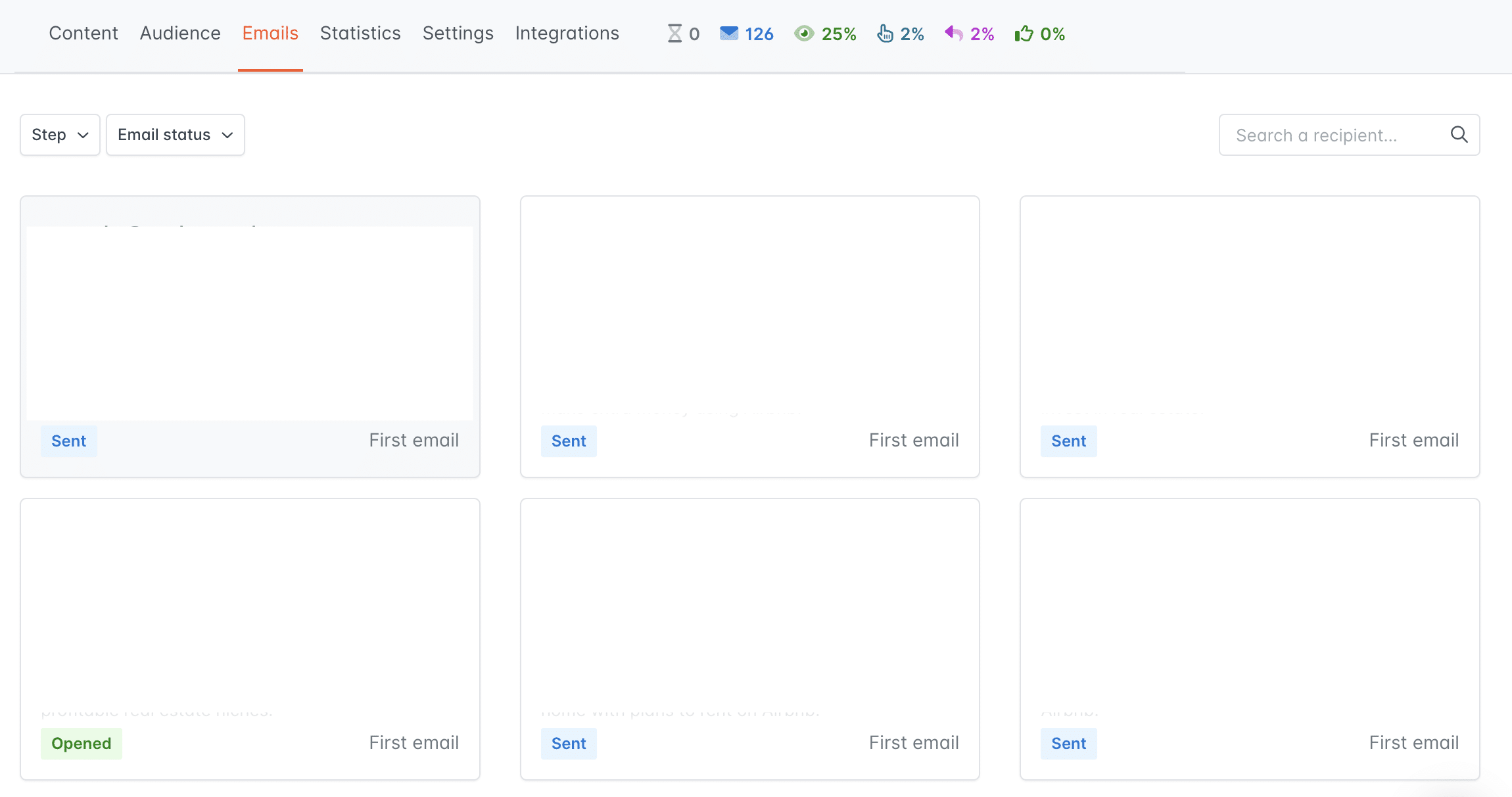
Here is an example of using Hunter to automate email campaigns and track their performance. The contents of the emails have been removed for confidentiality purposes.
The next step is to send your campaign and wait for a response from the site owner or editor. You want to send your campaign at the right time and frequency to maximize your chances of getting a positive response.
You can send your campaign by:
- Using an email outreach tool: You can use an email outreach tool like Hunter to automate and optimize your email outreach process. It can help you create personalized and customized emails, schedule and send them at the best time, track and measure their performance, and follow up until you get a response.
- Using a social media outreach tool: You can use a social media outreach tool like Hootsuite to automate and optimize your social media outreach process. It can help you create engaging and relevant posts, schedule and publish them at the best time, monitor and respond to their comments, and follow up until you get a response.
You want to send your campaign at a time when the recipient is most likely to open and read your email or post. This depends on various factors like their location, timezone, industry, and preferences.
Is Hunter.io a perfect tool for email campaigns? Find out in our Hunter.io review!
You also want to send your campaign at a frequency that is not too spammy or annoying, but not too passive or forgettable. You want to follow up with the recipient until you get a response, but not too often or too soon.
7. Tracking your efforts
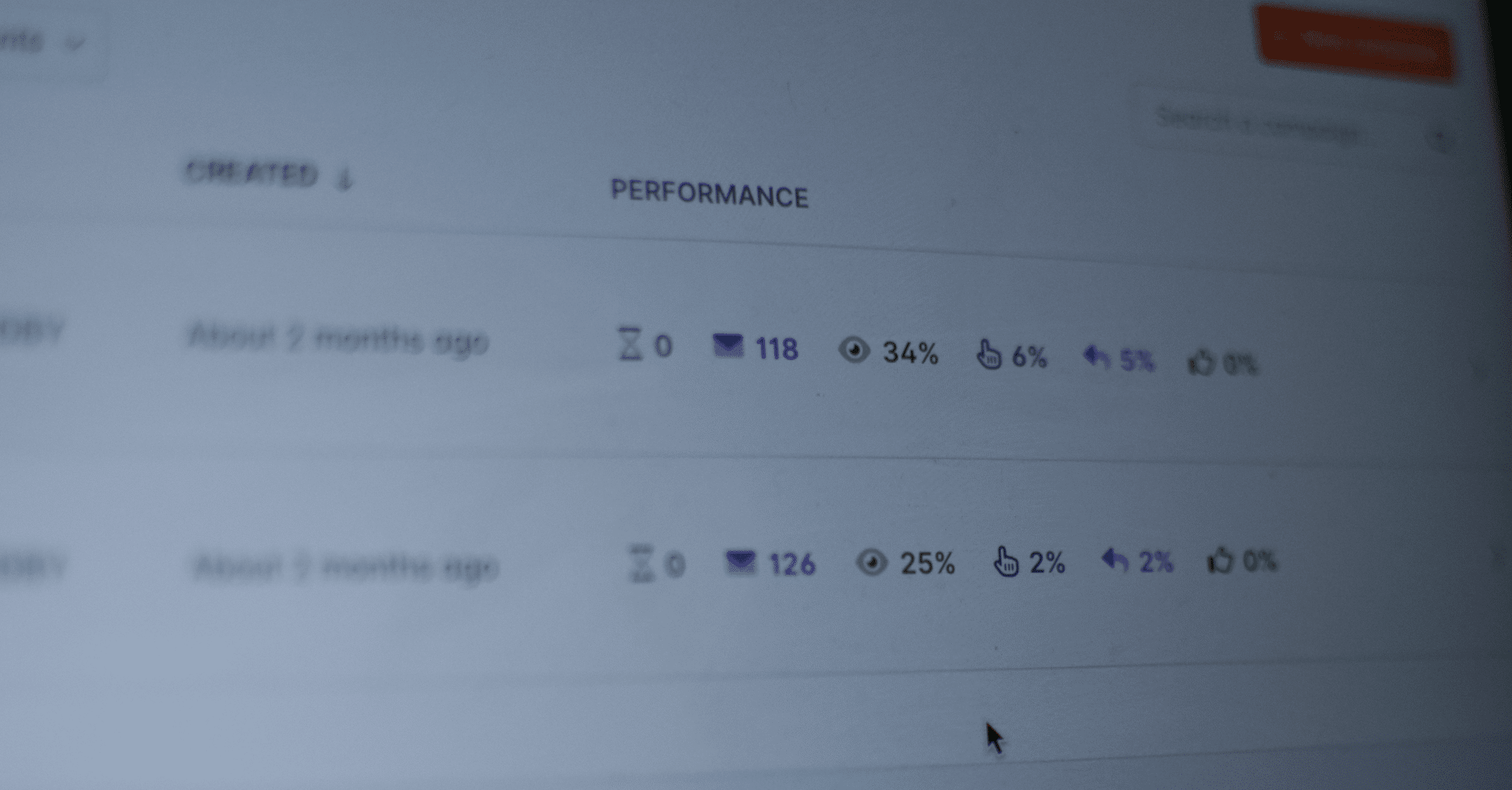
The final step is to track your efforts and measure your results. You want to track your efforts and measure your results to:
- Evaluate the effectiveness of your guest post outreach strategy
- Identify the strengths and weaknesses of your guest post outreach process
- Optimize and improve your guest blog outreach performance
- Achieve your guest post outreach goals
You can track your efforts and measure your results by:
- Using an email outreach tool: You can use an email outreach tool like Hunter to track and measure various metrics related to your email outreach campaign, such as open rate, click-through rate, reply rate, conversion rate, bounce rate, etc.
- Using a social media outreach tool: You can use a social media outreach tool like Hootsuite to track and measure various metrics related to your social media outreach campaign, such as reach, impressions, engagement, clicks, shares, comments, etc.
- Using an SEO tool: You can use an SEO tool like Ahrefs to track and measure various metrics related to your SEO performance, such as backlinks, domain authority, keyword rankings, organic traffic, leads, sales, etc.
Here are the other SEO tools you can use to outrank your competition!
You want to analyze and compare these metrics with your goals and benchmarks. See what works and doesn’t for your guest post outreach campaign. Learn from your successes and failures and make adjustments accordingly. If your emails still don’t have a sufficient delivery rate, make sure to check out our email deliverability guide.
Yes and No’s of Guest Post Outreach
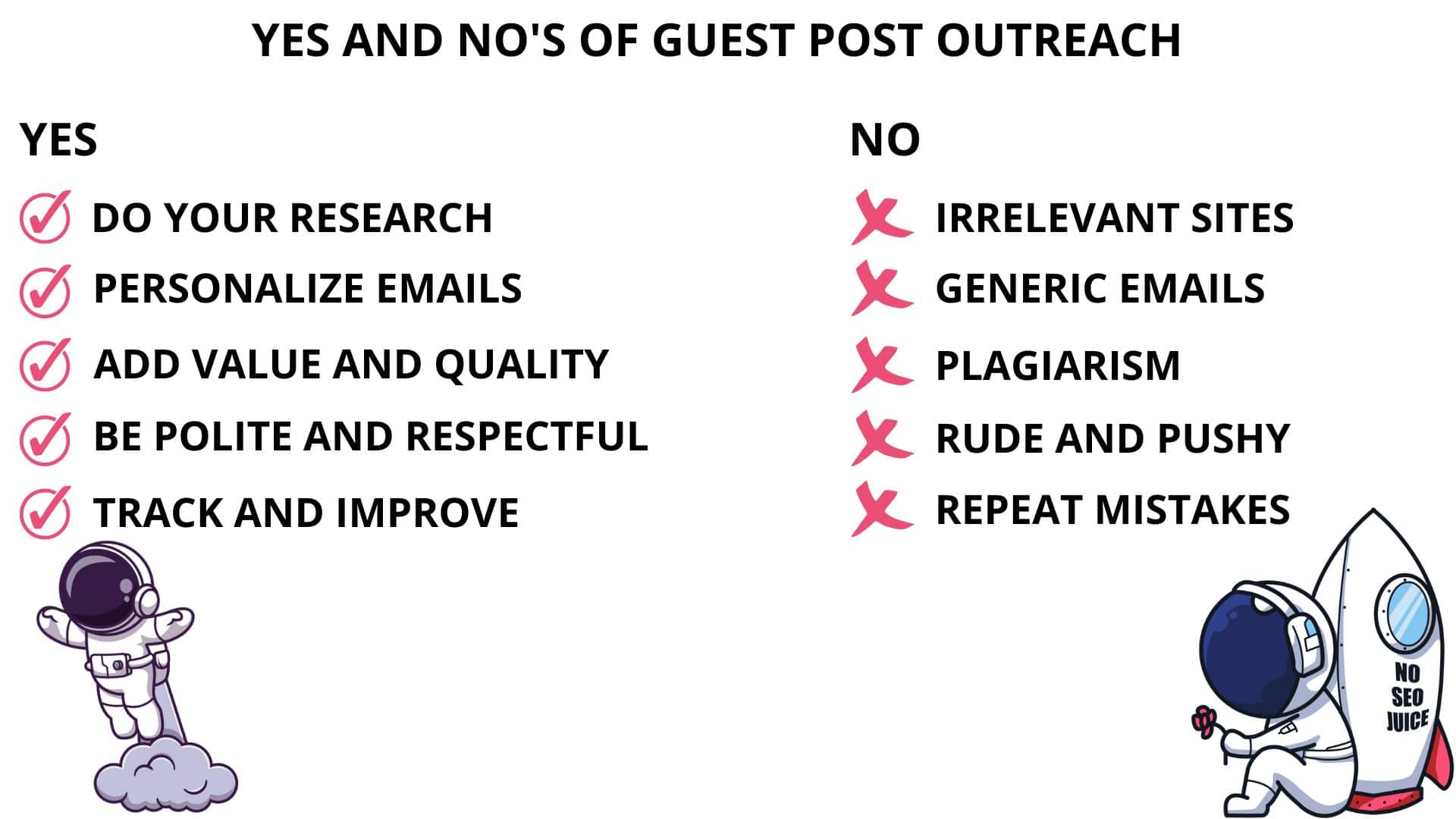
If done right, guest post outreach can be a rewarding and beneficial strategy for your online business. However, it can also be a frustrating and wasteful strategy if done wrong. Here are some yes and no’s of guest post outreach that will help you avoid common mistakes and increase your chances of success:
YES:
- Always do your research before pitching
- Always personalize and customize your emails
- Always provide value and quality in your content
- Always follow the guidelines and expectations of the host site
- Always be polite and respectful in your communication
- Always follow up until you get a response
- Always track and measure your results
- Always optimize and improve your process
NO:
- Never pitch irrelevant or low-quality sites
- Never send generic or spammy emails
- Never plagiarize or spin your content
- Never ignore the feedback or suggestions of the host site
- Never be rude or pushy in your communication
- Never give up after one or two attempts
- Never ignore or neglect your results
- Never repeat the same mistakes
Guest Posting Outreach Is Not Rocket Science!
Guest post outreach is a powerful and proven way to grow your online business in 2023 and beyond. It can help you build relationships, increase brand awareness, improve SEO, and generate leads. However, it requires a clear strategy and process to be effective and successful.
Now it’s your turn to take action and start implementing these tips and strategies in your own guest post outreach campaign. I’m sure you’ll see amazing results in no time!

